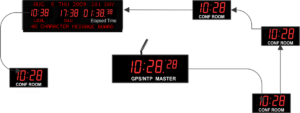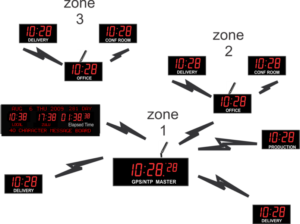MASTER AND SLAVE WIRED OR WIRELESS?
Now that we have a master clock, we need to sync all the slave clocks to our master clock. This can be done via a cat 5 twisted pair wiring in a daisy chain fashion or using our wireless technology to sync the clocks.
Similar to the GPS and NTP each system has its own advantage and disadvantages.
Wired synchronized network clock System:
Wired system will cost slightly more at the installation phase mainly to run the wires between all the clocks, and depending on your specific situation the total cost could be higher or lower than wireless system.
Wired system is considered to be more reliable, especially in locations that have a high network noise, and or
if the building has a lot of steel or thick concrete with steel.
Wireless synchronized network clock System:
These are easier to install, you can change the location of the clock very easily and don’t need
anyone to run wires for you. The cost of each clock is more expensive as they need to have a transceiver
to accept the signal. In some installations you will need a repeater or a master slave clock to carry the signal farther.
DDS wireless clock system operates on the 902-928 MHZ which is approved for use without a license in the
the US and Canada. In the open they can range a distance of up to 20 miles, and inside buildings some design and some trial and error will be required to get the optimized setup.
Our transceivers are high end using Frequency Hopping Spread Spectrum (FHSS) technology for secure communication protocol between the Transmitter and the Receiver,
Incase of data collisions they randomly change packet time to reduce data collisions.
And with over 32 possible channels they can operate in a very noisy environment.
Built for industrial use and can operate between -40c to 80c. Certifications:
FCC Part 15.247 KQL4x90-200 KQLAC4490
Industry Canada (IC) 2268C-4×90200 2268C-AC44901000
Need help to decide between wireless or wired system?
Want to test our affordable 6 sets synchronized clock system?





